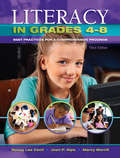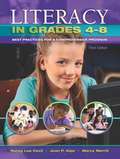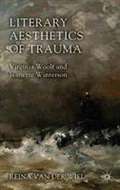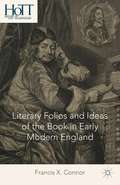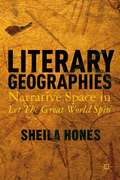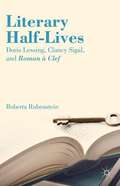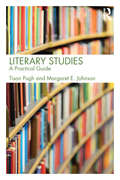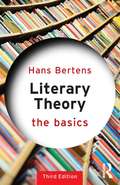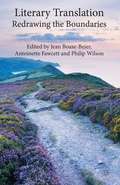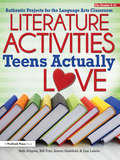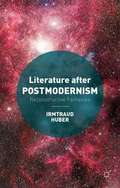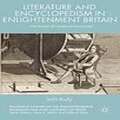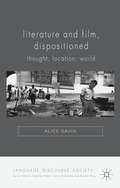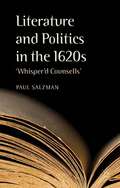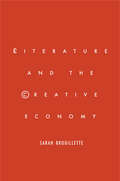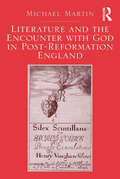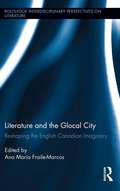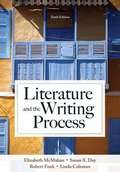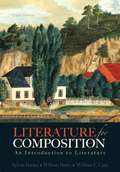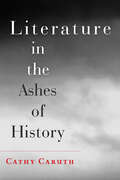- Table View
- List View
Literacy in Grades 4-8: Best Practices for a Comprehensive Program
by Joan P. Gipe Merrill E. Marcy Nancy L. CecilComprehensive yet succinct and readable, Literacy in Grades 4-8, Third Edition offers a wealth of practical ideas to help preservice and practicing teachers create a balanced and comprehensive literacy program while exploring the core topics and issues of literacy in grades 4 through 8. It addresses teaching to standards; differentiating instruction for readers and writers; motivating students; using assessment to inform instruction; integrating technology into the classroom; working with English learners and struggling readers; and connecting with caregivers. Selected classroom strategies, procedures, and activities represent the most effective practices according to research and the many outstanding classroom teachers who were observed and interviewed for the book. The Third Edition includes added material connecting the Common Core State Standards to the instruction and assessment of literacy skills; a combined word study and vocabulary chapter to help readers integrate these important topics in their teaching; more on technology, including comprehension of multimodal texts, enhancing writing instruction with technology tools, and teaching activities with an added technology component; added discussion of teacher techniques during text discussions, strategic moves that help students become more strategic readers.Key features: In the Classroom vignettes; more than 50 activities,some with a technology component; questions for journal writing and for projects and field-based activities; troubleshooting sections offering alternative suggestions and activities for those middle-grade students who may find a particular literacy focus challenging.
Literacy in Grades 4-8: Best Practices for a Comprehensive Program,Third Edition
by Nancy Lee Cecil Joan P. Gipe Marcy MerrillComprehensive yet succinct and readable, this book offers a wealth of practical ideas to help preservice and practicing teachers create a balanced and comprehensive literacy program while exploring the core topics and issues of literacy in grades 4 through 8. It addresses teaching to standards, including the Common Core State Standards; differentiating instruction for readers and writers; motivating students; using assessment to inform instruction; integrating technology into the classroom; working with English learners and struggling readers; and connecting with caregivers. Selected classroom strategies, procedures, and activities represent the most effective practices according to research and the many outstanding classroom teachers who were observed and interviewed for the book. Literacy in Grades 4 8 will give teachers the practical skills they need to motivate today s diverse learners.
Literary Aesthetics of Trauma: Virginia Woolf And Jeanette Winterson
by Reina van der WielLiterary Aesthetics of Trauma: Virginia Woolf and Jeanette Winterson investigates a fundamental shift, from the 1920s to the present day, in the way that trauma is aesthetically expressed. Modernism's emphasis on impersonality and narrative abstraction has been replaced by the contemporary trauma memoir and an ethical imperative to bear witness.
Literary Criticism from Plato to Postmodernism
by James SeatonThis book offers a history of literary criticism from Plato to the present, arguing that this history can best be seen as a dialogue among three traditions - the Platonic, Neoplatonic, and the humanistic, originated by Aristotle. There are many histories of literary criticism, but this is the first to clarify our understanding of the many seemingly incommensurable approaches employed over the centuries by reference to the three traditions. Making its case by careful analyses of individual critics, the book argues for the relevance of the humanistic tradition in the twenty-first century and beyond.
Literary Executions: Capital Punishment and American Culture, 1820–1925
by John Cyril BartonExamines literary and legal sources to document thoughts and feelings about capital punishment in the United States over the long nineteenth century.Drawing from legal and extralegal discourse but focusing on imaginative literature, Literary Executions examines representations of, responses to, and arguments for and against the death penalty in the United States over the long nineteenth century. John Cyril Barton creates a generative dialogue between artistic relics and legal history. He looks to novels, short stories, poems, and creative nonfiction as well as legislative reports, trial transcripts, legal documents, newspaper and journal articles, treatises, and popular books (like The Record of Crimes, A Defence of Capital Punishment, and The Gallows, the Prison, and the Poor House), all of which were part of the debate over the death penalty.Barton focuses on several canonical figures—James Fenimore Cooper, Nathaniel Hawthorne, Lydia Maria Child, Walt Whitman, Herman Melville, and Theodore Dreiser—and offers new readings of their work in light of the death penalty controversy. Barton also gives close attention to a host of then-popular-but-now-forgotten writers—particularly John Neal, Slidell MacKenzie, William Gilmore Simms, Sylvester Judd, and George Lippard—whose work helped shape or was shaped by the influential anti-gallows movement. Analyzing the tension between sovereignty and social responsibility in a democratic republic, Barton argues that the high stakes of capital punishment dramatize the confrontation between the citizen-subject and sovereign authority in its starkest terms. In bringing together the social and the aesthetic, Barton shows how legal forms informed literary forms and traces the emergence of the modern State in terms of the administration of lawful death.By engaging the politics and poetics of capital punishment, Literary Executions contends that the movement to abolish the death penalty in the United States should be seen as an important part of the context that brought about the flowering of the American Renaissance during the antebellum period and that influenced literature later in the nineteenth and early twentieth centuries.
Literary Executions: Capital Punishment and American Culture, 1820–1925
by John Cyril Barton“Rich with historical detail . . . examines the figure and theme of the death penalty in imaginative literature from Cooper to Dreiser.” —Gregg Crane, Professor of English Language and Literature, University of MichiganDrawing from legal and extralegal discourse but focusing on imaginative literature, Literary Executions examines representations of, responses to, and arguments for and against the death penalty in the United States over the long nineteenth century. John Cyril Barton creates a generative dialogue between artistic relics and legal history. He looks to novels, short stories, poems, and creative nonfiction as well as legislative reports, trial transcripts, legal documents, newspaper and journal articles, treatises, and popular books (like The Record of Crimes, A Defence of Capital Punishment, and The Gallows, the Prison, and the Poor House), all of which were part of the debate over the death penalty.Barton focuses on several canonical figures—James Fenimore Cooper, Nathaniel Hawthorne, Lydia Maria Child, Walt Whitman, Herman Melville, and Theodore Dreiser—and offers new readings of their work in light of the death penalty controversy. Barton also gives close attention to a host of then-popular-but-now-forgotten writers—particularly John Neal, Slidell MacKenzie, William Gilmore Simms, Sylvester Judd, and George Lippard—whose work helped shape or was shaped by the influential anti-gallows movement.By engaging the politics and poetics of capital punishment, Literary Executions contends that the movement to abolish the death penalty in the United States should be seen as an important part of the context that brought about the flowering of the American Renaissance during the antebellum period and that influenced literature later in the nineteenth and early twentieth centuries
Literary Folios and Ideas of the Book in Early Modern England
by Francis X. ConnorThis monograph makes clear how the format of the literary folio played a fundamental role in book history by encapsulating the unstable negotiation between commerce, cultural prestige, and the fundamental nature of the printed book.
Literary Geographies: Narrative Space in Let The Great World Spin
by Sheila HonesCombining literary analysis with a practical introduction to interdisciplinary literary geography, Literary Geograp hie s examines key elements of Colum McCann's 2009 novel, Let the Great World Spi n . Hones examines concepts such as narrative space, literary and academic collaboration, and the geographies of creation, production, and reception.
Literary Half-Lives
by Roberta RubensteinWhile Doris Lessing was composing The Golden Notebook , she was intimately involved with Clancy Sigal and their relationship influenced the literary methods of both writers. Focusing on literary transformations, Rubenstein offers compelling insights into the ethical implications of disguised autobiography and roman #65533; clef .
Literary Studies: A Practical Guide
by Tison Pugh Margaret E. JohnsonLiterary Studies: A Practical Guide provides a comprehensive foundation for the study of English, American, and world literatures, giving students the critical skills they need to best develop and apply their knowledge. Designed for use in a range of literature courses, it begins by outlining the history of literary movements, enabling students to contextualize a given work within its cultural and historical moment. Specific focus is then given to the use of literary theory and the analysis of: Poetry Prose fiction and novels Plays Films. A detailed unit provides clear and concise introductions to literary criticism and theory, encouraging students to nurture their unique insights into a range of texts with these critical tools. Finally, students are guided through the process of generating ideas for essays, considering the role of secondary criticism in their writing, and formulating literary arguments. This practical volume is an invaluable resource for students, providing them with the tools to succeed in any English course.
Literary Theory: The Basics (The Basics)
by Hans BertensThis third edition of Hans Bertens' bestselling book is an essential guide to the often confusing and complicated world of literary theory. Exploring a broad range of topics from Marxist and feminist criticism to postmodernism and new historicism Literary Theory: The Basics covers contemporary topics including: reception theory and reader response theory the new criticism of postmodernism the 'after theory' debate post-humanism, biopolitics and animal studies aesthetics Literary Theory: The Basics helps readers to approach the many theories and debates in this field with confidence. Now with updated case studies and further reading this is an essential purchase for anyone who strives to understand literary theory today.
Literary Translation
by Jean Boase-BeierLiterary Translation: Redrawing the Boundaries is a collection of articles that gathers together current work in literary translation to show how research in the field can speak to other disciplines such as cultural studies, history, linguistics, literary studies and philosophy, whilst simultaneously learning from them.
Literature 5 Student Guide Part 2
by The Editors at the K12 Inc.Literature 5 educational student work sheets
Literature Activities Teens Actually Love: Authentic Projects for the Language Arts Classroom (Grades 9-12)
by Beth Ahlgrim Bill Fritz Jeremy GertzfieldInstead of asking literature to meet the entertainment, cultural, and of course educational needs of today's youth, Literature Activities Teens Actually Love empowers teachers to guide students in working with literature on their own terms in order to rediscover the joys it holds. Through a variety of innovative and highly engaging projects, this book will develop a new lens through which to view literature and its study, with activities that are at once highly entertaining yet encourage higher order thinking skills and strategies. Lesson plans incorporating alternatives as diverse as Facebook and quilting show how teachers and students can bridge the technology gap by finding creative solutions to traditional academic problems. By allowing students to use their technological skills to move from print to nonprint assessments, students will have the opportunity to explore the text with a greater degree of ownership over the process, resulting in autonomous learners. Grades 9-12
Literature after Postmodernism
by Irmtraud HuberLiterature after Postmodernism explores the use of literary fantastic storylines in contemporary novels which begin to think beyond postmodernism. They develop an aesthetic perspective that aims at creation and communication instead of subversion and can thus be considered no longer deconstructive but reconstructive.
Literature and Encyclopedism in Enlightenment Britain
by Seth RudyAt a moment when Google seeks "to organize the world's information and make it universally accessible and useful," this book tells the story of long-term aspirations, first in ancient epic and then in a wide range of literary and non-literary works from the early modern era and British Enlightenment, to comprehend, record, and disseminate complete knowledge of the world. It is also a story of the persistent failure of these aspirations, their collapse in the late eighteenth century, and the subsequent redefinition of completeness in modern literary and disciplinary terms. The book argues that the pursuit of complete knowledge advanced the separation of epic from encyclopedia, literature from "Literature," and the sciences from the humanities; it demonstrates that the distinctions between "high" and "low," ephemeral and eternal, useful and useless that persist today all stem from the concepts of completeness that emerged during and as a result of the Enlightenment.
Literature and Encyclopedism in Enlightenment Britain: The Pursuit of Complete Knowledge (Palgrave Studies in the Enlightenment, Romanticism and Cultures of Print)
by Seth RudyLiterature and Encyclopedism in Enlightenment Britain tells the story of long-term aspirations to comprehend, record, and disseminate complete knowledge of the world. It draws on a wide range of literary and non-literary works from the early modern era and British Enlightenment.
Literature and Film, Dispositioned
by Alice GavinLiterature and Film, Dispositioned looks to twentieth-century literature's encounter with film silent film in particular as a means to thinking about the locations of thought in literature. Interested especially in theories of free indirect style both literary and filmic, it brings these theories together by seeing the free indirect as involving less the representation of interiority than a disposition (a subjective temperament) that is also a dispositioning (subjectivity's displacement, or else its eclipsical quitting). In this sense, the book is also more broadly an exploration of the disposition of literature, the ways in which literature is disposed to the world, in the world. Meditative in its analyses, the book includes readings of works by James Joyce, Henry James, Virginia Woolf, and Samuel Beckett; whose Film (1965) filmed in New York City and starring a wizened and wrinkled Buster Keaton forms a concluding focus. "
Literature and Politics in the 1620s
by Paul SalzmanThis exciting study of the literature of the 1620s argues that during the decade a huge range of writing and performance reflected the growing hunger of readers and audiences for political information and commentary mediated through literature. The comparatively neglected decade is reshaped by this book, which argues that literature was inextricably linked to politics, whether oppositional or authoritarian. A wide range of texts are analyzed, from Shakespeare's First Folio to Middleton's A Game At Chess, from romances and poetry to sermons, tracts and newsbooks. Salzman argues that the flow and counterflow of these texts was part of a cultivated practice of reading and writing, that politicized every moment as a contest of ideas. This is literary history at its most innovative and informative. Additional materials for Literature and Politics in the 1620s can be found here: http: //www. latrobe. edu. au/humanities/research/specialisations/literary-studies
Literature and the Creative Economy
by Sarah BrouilletteFor nearly twenty years, social scientists and policy makers have been highly interested in the idea of the creative economy. This book contends that mainstream considerations of the economic and social force of culture, including theories of the creative class and of cognitive and immaterial labor, are indebted to historic conceptions of the art of literary authorship. What's more, it shows how contemporary literature has been involved in and has responded to creative-economy phenomena, including the presentation of artists as models of contentedly flexible and self-managed work, the treatment of training in and exposure to art as a pathway to social inclusion, the use of culture and cultural institutions to increase property values, and support for cultural diversity as a means of growing cultural markets. Contemporary writers have not straightforwardly bemoaned these phenomena in a classic rejection of the instrumental application of art. Rather, they have tended to explore how their own critical capacities have become compatible with or even essential to a neoliberal economy that has embraced art's autonomous gestures as proof that authentic self-articulation and social engagement can and should occur within capitalism. Taking a sociological approach to literary criticism, Brouillette interprets major works of contemporary fiction by Monica Ali, Aravind Adiga, Daljit Nagra, and Ian McEwan alongside government policy, social science, and theoretical explorations of creative work and immaterial labor.
Literature and the Encounter with God in Post-Reformation England: Literature And The Encounter With God In Post-reformation England, C. 1550--1704
by Michael MartinEach of the figures examined in this study”John Dee, John Donne, Sir Kenelm Digby, Henry and Thomas Vaughan, and Jane Lead”is concerned with the ways in which God can be approached or experienced. Michael Martin analyzes the ways in which the encounter with God is figured among these early modern writers who inhabit the shared cultural space of poets and preachers, mystics and scientists. The three main themes that inform this study are Cura animarum, the care of souls, and the diminished role of spiritual direction in post-Reformation religious life; the rise of scientific rationality; and the struggle against the disappearance of the Holy. Arising from the methods and commitments of phenomenology, the primary mode of inquiry of this study resides in contemplation, not in a religious sense, but in the realm of perception, attendance, and acceptance. Martin portrays figures such as Dee, Digby, and Thomas Vaughan not as the eccentrics they are often depicted to have been, but rather as participating in a religious mainstream that had been radically altered by the disappearance of any kind of mandatory or regular spiritual direction, a problem which was further complicated and exacerbated by the rise of science. Thus this study contributes to a reconfiguration of our notion of what ’religious orthodoxy’ really meant during the period, and calls into question our own assumptions about what is (or was) ’orthodox’ and ’heterodox.’
Literature and the Glocal City: Reshaping the English Canadian Imaginary (Routledge Interdisciplinary Perspectives on Literature)
by Ana María Fraile-MarcosThe modern city is a space that can simultaneously represent the principles of its homeland alongside its own unique blend of the cultures that intermingle within its city limits. This book makes an intervention in Canadian literary criticism by foregrounding both ‘globalism,’ which is increasingly perceived as the state-of-the-art literary paradigm, and the city. These are two significant axes of contemporary culture and identity that were previously disregarded by a critical tradition built around the importance of space and place in Canadian writing. Yet, as relevant as the turn to the city and to globalism may be, this collection’s most notable contribution lies in linking the notion of ‘glocality’, that is, the intermeshing of local and global forces to representations of subjectivity in the material and figurative space of the Canadian city. Dealing with oppositional discourses as multiculturalism, postcolonialism, feminism, diaspora, and environmentalism this book is an essential reference for any scholar with an interest in these areas.
Literature and the Writing Process 10th Edition
by Elizabeth Mcmahan Robert Funk Susan X Day Linda S. ColemanLiterature and the Writing Process combines the best elements of a literature anthology with those of a handbook to guide students through the interrelated process of analytical reading and critical writing.
Literature for Composition: An Introduction to Literature
by Sylvan Barnet William E. Cain William BurtoLiterature for Composition is based on the assumption that students in composition or literature courses should encounter first-rate writing--not simply competent prose but the powerful reports of experience that have been recorded by highly skilled writers of the past and present, reports of experiences that must be shared. Our view is not original.
Literature in the Ashes of History
by Cathy CaruthWhat does it mean for history to disappear?Outstanding Academic Title, ChoiceCathy Caruth juxtaposes the writings of psychoanalysts, literary and political theorists, and literary authors who write in a century faced by a new kind of history, one that is made up of events that seem to undo, rather than produce, their own remembrance. At the heart of each chapter is the enigma of a history that, in its very unfolding, seems to be slipping away before our grasp. What does it mean for history to disappear? And what does it mean to speak of a history that disappears? These questions, Caruth suggests, lie at the center of the psychoanalytic texts that frame this book, as well as the haunting stories and theoretical arguments that resonate with each other in profound and surprising ways. In the writings of Honoré de Balzac, Hannah Arendt, Ariel Dorfman, Wilhelm Jensen, Sigmund Freud, and Jacques Derrida, we encounter, across different stakes and different languages, a variety of narratives that bear witness not simply to the past but also to the pasts we have not known and that repeatedly return us to a future that remains beyond imagination.These stories of trauma cannot be limited to the catastrophes they name, and the theory of catastrophic history may ultimately be written in a language that already lingers in a time that comes to us from the other side of the disaster.
